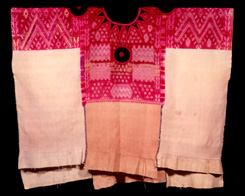
 raditionally, each article of hand-woven Guatemalan clothing communicates the wearerÆs identity. Patterns, colors, and fibers provide information about the wearerÆs village, age, and marital and economic status. Certain costumes are intended for daily wear, others for specific ceremonies.
raditionally, each article of hand-woven Guatemalan clothing communicates the wearerÆs identity. Patterns, colors, and fibers provide information about the wearerÆs village, age, and marital and economic status. Certain costumes are intended for daily wear, others for specific ceremonies.The huipil is the upper body covering worn by women. It is made of one, two, or three rectangles sewn together, with a hole for the head. Huipiles are woven on either a backstrap or foot loom. This huipil comes from Chichicastenango, where the people are descended from the Quiche Maya. Although women in Chichicastenango weave huipiles for themselves and the female members of their families, men have traditionally produced the intricate appliqué and embroidery around the neck of each huipil.